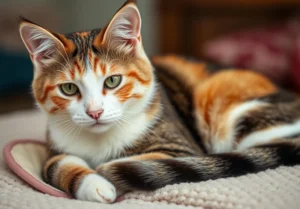When the skies darken or the temperature hits extreme highs and lows, our four-legged friends can act a bit kooky, can’t they? From thunderstorm-induced zoomies to heatwave lethargy, who knew the weather could wield such power over our feline overlords?
Promise you this: by the end of this blog post, you’ll have a toolbox brimming with strategies to keep your cat calm, composed, and maybe even a little carefree, no matter what Mother Nature throws your way.
Key takeaways:
- Keep your cat calm during thunderstorms by playing soothing music and providing a cozy hideout.
- Prevent heat stress with ample fresh, cool water and access to shaded or cool areas.
- Monitor for signs of weather-related anxiety, such as hiding or excessive grooming, and consider a vet visit for persistent issues.
Why Does Extreme Weather Affect Cat Behavior?
Ever wonder why your feline friend turns into a furball of chaos whenever the weather takes a turn for the extreme? You’re not alone. The shift in a cat’s demeanor during various weather extremes isn’t just chance; there’s a real science behind it.
Factors such as changes in atmospheric pressure and temperature fluctuations can genuinely ruffle your cat’s metaphorical feathers. For instance, a drop in atmospheric pressure, which often precedes storms, can make cats feel uneasy. This is because cats, with their acute sensitivity to their environment, can detect these changes long before humans can. Similarly, extreme temperatures can lead to discomfort, making your cat more irritable or lethargic.
Additionally, the heightened stress levels caused by these environmental changes can significantly impact their behavior, making them more anxious or even agitated. Understanding these cues can help cat owners provide the necessary support during these times.
How Can You Keep Your Cat Calm During Thunderstorms?
Thunderstorms can be particularly distressing for cats. Their keen sense of hearing makes thunder a frightening experience. Here are some tips to help soothe your feline during these loud events:
-
Use Calming Pheromones : Products such as Feliway mimic the natural calming pheromones that cats produce, helping to soothe their nerves during stressful situations.
-
Create a Cozy Hideout : Cats often seek out small, enclosed spaces to feel safe. Ensure your cat has access to a quiet, dark space, like a box in a seldom-used closet, to retreat to when the thunder rolls in.
-
Play Soothing Music : It might sound a bit out of left field, but playing calming sounds or classical music can help mask the sound of thunder. Anecdotal evidence suggests that music specifically composed for calming cats can be particularly effective.
One unique tip that’s often overlooked is to engage your cat in a play session before the storm hits. Playing helps your cat release pent-up energy and reduces anxiety, making them more likely to sleep through the storm.
What About the Heat? Keeping Your Cat Cool and Collected
As the mercury rises, keeping your cat cool becomes crucial. Overheating can lead to heatstroke, a potentially fatal condition. Here’s how to ensure your cat stays cool and comfortable:
-
Hydration is Key : Always provide fresh, cool water. Consider adding ice cubes to the water on extremely hot days for that extra bit of refreshment.
-
Find Cool, Shady Spots : Ensure your cat has access to shaded areas, especially if they enjoy basking in the sun. An elevated cooling bed can also provide a comfortable retreat.
-
Recognize Signs of Heatstroke : Heavy panting, drooling, lethargy, and rapid heartbeat are all warning signs. Act immediately by moving your cat to a cooler area and contacting your vet.
A novel idea to keep your cat cool is to freeze small treats or toys in ice. Letting your cat play with or lick the ice can provide both stimulation and a way to cool down. This strategy not only combats the heat but also keeps your cat mentally engaged.
Remember, while these tips provide a starting point, every cat is unique. Observing and understanding your cat’s individual needs and behavioral cues is paramount. By applying these strategies, you can create a comforting environment for your cat, regardless of the weather’s whims.
Stay tuned for more insights on how to ensure your cat’s well-being through every season’s challenges.
Can Changes in Weather Cause Anxiety in Cats?
Indeed, cats, like humans, can feel the pressure of changing weather patterns, sometimes resulting in anxiety or stress.
Ever noticed your feline friend acting a bit off when a storm brews on the horizon? That’s them reacting to the drop in atmospheric pressure, not just an old wives’ tale. Let’s unravel the signs of weather-induced anxiety in cats and explore strategies to help them stay calm, come rain or shine.
Signs Your Cat May Be Anxious Due to Weather Changes
Cats are creatures of habit, and any disruption in their daily routine, including those caused by extreme weather, can lead to anxiety. Here are a few signs to watch for:
- Hiding more often: If your cat is suddenly finding new hideouts or spending more time under the bed during bad weather, it might be their way of seeking comfort.
- Increased vocalization: Meowing, hissing, or growling more than usual can be a signal that the stormy weather outside is causing them distress.
- Changes in appetite or litter box habits: Stress can either put your cat off their food or drive them to eat excessively. Similarly, accidents outside the litter box can be a sign of anxiety.
- Excessive grooming: Cats might start grooming themselves more than usual as a way to self-soothe.
Long-Term Strategies for Managing Weather-Related Anxiety in Cats
Creating a Safe Space
One of the most effective ways to help your cat cope with their anxiety is by creating a safe, secure space where they can escape the scary sounds and pressure changes associated with extreme weather. This could be a quiet room away from windows or a cozy nook with their favorite blanket and toys.
Environmental Modifications
Consider these additional modifications to make your home more comfortable for your anxious cat:
- Soundproofing: Adding thick curtains or window inserts can help muffle the sound of thunder or heavy rain.
- Calming diffusers: Products that mimic feline pheromones can create a sense of safety and well-being for your cat.
- Interactive toys: Keeping their mind off the bad weather with puzzles or toys can also relieve stress.
When to Seek Advice from a Vet
If you’ve tried these strategies and your cat’s anxiety does not seem to improve, it might be time to consult with your veterinarian. They can offer advice specific to your cat’s needs, which might include medication for severe cases or referral to a feline behavior specialist.
Unique Insight: The Power of Classical Music
Here’s a nugget of wisdom that not everyone might think of: playing classical music during storms or extreme weather events. Studies have shown that classical music can have a calming effect on cats, just as it does on humans. A soft melody in the background can distract and soothe your cat, making the thunder seem less threatening. It’s a simple, yet effective strategy to add to your toolkit.
In summary, while extreme weather can indeed stir anxiety in our feline companions, understanding the signs and knowing how to respond can make a big difference. From creating a safe space to consulting with a vet, these strategies are designed to offer comfort and relief to your cat, ensuring they ride out the storm as calmly as possible. Remember, every cat is unique, so paying close attention to how they react to different strategies will help you find the perfect balance to keep them comfortable, no matter what the weather brings.
Alex, a passionate animal lover, has experience in training and understanding animal behavior. As a proud pet parent to two dogs and three cats, he founded AnimalReport.net to share insights from animal experts and expand his knowledge of the animal kingdom.





